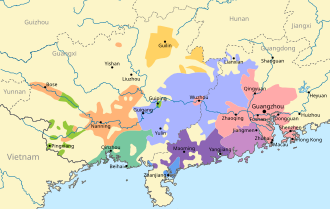Cantonese



File:字言字語 手遊"課金" 曾鈺成 am730.webm Cantonese is a variety of Chinese spoken in the Guangdong province, the Hong Kong and Macau Special Administrative Regions, and parts of the Southeast Asian region. It is one of the five major Chinese dialects and is part of the Yue Chinese group of dialects. Cantonese is known for its rich tones, with six to nine tones depending on the dialect region, which adds to the complexity and expressiveness of the language.
History[edit]
The history of Cantonese can be traced back to the Tang dynasty, when Guangzhou became a major port and trading center, leading to the development of the language as a distinct dialect. Over centuries, Cantonese evolved and spread, especially in southern China. During the 19th and early 20th centuries, many Cantonese speakers emigrated overseas, establishing Cantonese-speaking communities around the world, particularly in North America, Australia, and Southeast Asia.
Geographical Distribution[edit]
Cantonese is predominantly spoken in the Guangdong province, Hong Kong, and Macau. It is also widely spoken among overseas Chinese communities, especially in countries like the United States, Canada, Australia, and Malaysia. In these international communities, Cantonese serves as a cultural and linguistic link to China.
Phonology[edit]
Cantonese phonology is notable for its complex tone system. The language traditionally has six tones, but in some dialects, there are up to nine. This tonal system is a defining characteristic of Cantonese and is crucial for distinguishing meanings between words that otherwise have the same series of consonants and vowels.
Grammar[edit]
Cantonese grammar does not rely on inflectional morphemes to indicate tense, mood, or case. Instead, it uses a combination of word order, auxiliary verbs, and context to convey grammatical relationships. The basic word order is Subject-Verb-Object (SVO), similar to English.
Writing System[edit]
Cantonese is written using traditional Chinese characters. However, due to its unique vocabulary and expressions, some characters used in written Cantonese are not found in other Chinese dialects. There are also colloquial characters specific to Cantonese that are used in informal writing and social media.
Cultural Significance[edit]
Cantonese holds significant cultural importance in Guangdong, Hong Kong, and Macau. It is the language of many famous Chinese films, music, and literature. The Cantonese opera is a traditional art form that is still popular today. Cantonese cuisine, known for its variety and flavors, is also an integral part of the culture.
Challenges and Preservation[edit]
In recent years, the dominance of Mandarin Chinese as the official language of China and its promotion in education has posed challenges to the preservation of Cantonese. However, there is a strong movement to preserve Cantonese culture and language, especially in Hong Kong and among overseas communities.
Ad. Transform your life with W8MD's Budget GLP-1 injections from $75


W8MD offers a medical weight loss program to lose weight in Philadelphia. Our physician-supervised medical weight loss provides:
- Weight loss injections in NYC (generic and brand names):
- Zepbound / Mounjaro, Wegovy / Ozempic, Saxenda
- Most insurances accepted or discounted self-pay rates. We will obtain insurance prior authorizations if needed.
- Generic GLP1 weight loss injections from $75 for the starting dose.
- Also offer prescription weight loss medications including Phentermine, Qsymia, Diethylpropion, Contrave etc.
NYC weight loss doctor appointmentsNYC weight loss doctor appointments
Start your NYC weight loss journey today at our NYC medical weight loss and Philadelphia medical weight loss clinics.
- Call 718-946-5500 to lose weight in NYC or for medical weight loss in Philadelphia 215-676-2334.
- Tags:NYC medical weight loss, Philadelphia lose weight Zepbound NYC, Budget GLP1 weight loss injections, Wegovy Philadelphia, Wegovy NYC, Philadelphia medical weight loss, Brookly weight loss and Wegovy NYC
|
WikiMD's Wellness Encyclopedia |
| Let Food Be Thy Medicine Medicine Thy Food - Hippocrates |
Medical Disclaimer: WikiMD is not a substitute for professional medical advice. The information on WikiMD is provided as an information resource only, may be incorrect, outdated or misleading, and is not to be used or relied on for any diagnostic or treatment purposes. Please consult your health care provider before making any healthcare decisions or for guidance about a specific medical condition. WikiMD expressly disclaims responsibility, and shall have no liability, for any damages, loss, injury, or liability whatsoever suffered as a result of your reliance on the information contained in this site. By visiting this site you agree to the foregoing terms and conditions, which may from time to time be changed or supplemented by WikiMD. If you do not agree to the foregoing terms and conditions, you should not enter or use this site. See full disclaimer.
Credits:Most images are courtesy of Wikimedia commons, and templates, categories Wikipedia, licensed under CC BY SA or similar.
Translate this page: - East Asian
中文,
日本,
한국어,
South Asian
हिन्दी,
தமிழ்,
తెలుగు,
Urdu,
ಕನ್ನಡ,
Southeast Asian
Indonesian,
Vietnamese,
Thai,
မြန်မာဘာသာ,
বাংলা
European
español,
Deutsch,
français,
Greek,
português do Brasil,
polski,
română,
русский,
Nederlands,
norsk,
svenska,
suomi,
Italian
Middle Eastern & African
عربى,
Turkish,
Persian,
Hebrew,
Afrikaans,
isiZulu,
Kiswahili,
Other
Bulgarian,
Hungarian,
Czech,
Swedish,
മലയാളം,
मराठी,
ਪੰਜਾਬੀ,
ગુજરાતી,
Portuguese,
Ukrainian
